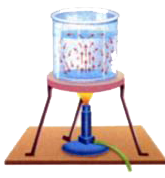Name the process associated with the following
(a) Dry ice is kept at room temperature and at one atmospheric pressure.
(b) A drop of ink placed on the surface of water contained in a glass spreads throughout the water.
(c) A potassium permanganate crystal is in a beaker and water is poured into the beaker with stirring.
(d) An acetone bottle is left open and the bottle becomes empty.
(e) Milk is churned to separate cream from it.
(f) Settling of sand when a mixture of sand and water is left undisturbed for some time.
(g) Fine beam of light entering through a small hole in a dark room. Illuminates the particles in its paths.
Step-by-Step Solution
1. Dry ice is kept at room temperature and at one atmospheric pressure.
- Process: Sublimation
- Explanation: Dry ice, which is solid carbon dioxide (CO2), changes directly from a solid to a gas when exposed to room temperature and atmospheric pressure, without becoming a liquid.
2. A drop of ink placed on the surface of water contained in a glass spreads throughout the water.
- Process: Diffusion
- Explanation: The ink molecules move from an area of higher concentration (the drop) to areas of lower concentration (the surrounding water) until they are evenly distributed.
3. A potassium permanganate crystal is in a beaker and water is poured into the beaker with stirring.
- Process: Dissolution (or Diffusion)
- Explanation: The potassium permanganate crystal dissolves in the water, resulting in a homogeneous solution as the solute (potassium permanganate) spreads throughout the solvent (water).
4. An acetone bottle is left open and the bottle becomes empty.
- Process: Evaporation
- Explanation: Acetone, being a volatile liquid, evaporates into the air when the bottle is left open, leading to the bottle becoming empty.
5. Milk is churned to separate cream from it.
- Process: Centrifugation
- Explanation: Churning milk causes the denser skimmed milk to separate from the lighter cream due to the centrifugal force generated during the churning process.
6. Settling of sand when a mixture of sand and water is left undisturbed for some time.
- Process: Sedimentation
- Explanation: When the mixture is left undisturbed, the sand particles settle at the bottom due to gravity, forming a sediment.
7. Fine beam of light entering through a small hole in a dark room illuminates the particles in its path.
- Process: Tyndall Effect
- Explanation: The scattering of light by small particles suspended in the air (like dust) causes the beam of light to become visible, demonstrating the Tyndall effect.
- Process: Sublimation
- Explanation: Dry ice, which is solid carbon dioxide (CO2), changes directly from a solid to a gas when exposed to room temperature and atmospheric pressure, without becoming a liquid.
- Process: Diffusion
- Explanation: The ink molecules move from an area of higher concentration (the drop) to areas of lower concentration (the surrounding water) until they are evenly distributed.
- Process: Dissolution (or Diffusion)
- Explanation: The potassium permanganate crystal dissolves in the water, resulting in a homogeneous solution as the solute (potassium permanganate) spreads throughout the solvent (water).
- Process: Evaporation
- Explanation: Acetone, being a volatile liquid, evaporates into the air when the bottle is left open, leading to the bottle becoming empty.
- Process: Centrifugation
- Explanation: Churning milk causes the denser skimmed milk to separate from the lighter cream due to the centrifugal force generated during the churning process.
- Process: Sedimentation
- Explanation: When the mixture is left undisturbed, the sand particles settle at the bottom due to gravity, forming a sediment.
- Process: Tyndall Effect
- Explanation: The scattering of light by small particles suspended in the air (like dust) causes the beam of light to become visible, demonstrating the Tyndall effect.
Similar Questions
Knowledge Check
Which one of the following substances has highest specific heat capacity at room temperature and atmospheric pressure ? a) Water b) Ice c) Aluminum d) Mercury
AWaterBIceCAluminiumDMercurySteam is passed through the water contained in a beaker. The water can boil, when the steam is at
Aatmospheric pressureBpressure height than the atmosphereCpressure lower than the atmosphereDany pressureIf water in a closed bottle is taken up to the moon and open, the water gets
AfreezedBboiledCdissociated into O2andH2Devaporated
Water is taken in one beaker and glycerine in another. Both are stirred well and kept on the table. Which will come to rest first?
View SolutionAn ice cube containing a galss ball is floating on the surface of water contained in a trough. The whole of the ice melts, the level of water in the trough
View SolutionWhy are aerated water bottles kept under water during summer ?
View SolutionWhen a beaker of water is heated with a bit of potassium permanganate at the bottom you can see purple coloured water move up and down in circular paths. Why?

View SolutionWhen the water in a beaker is heated the warm water
View Solution
